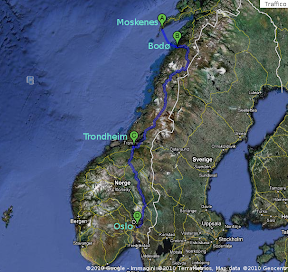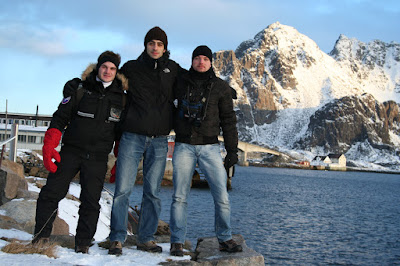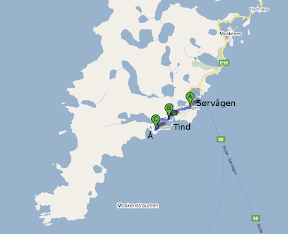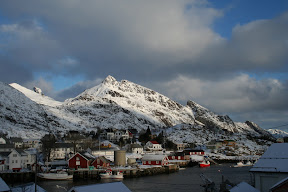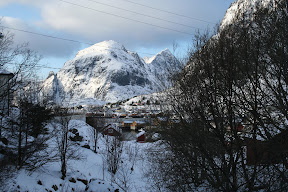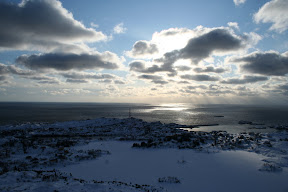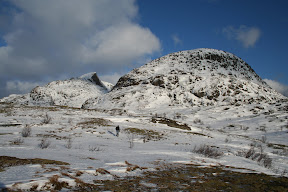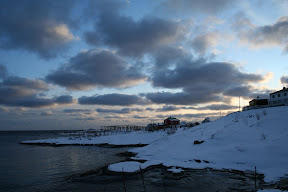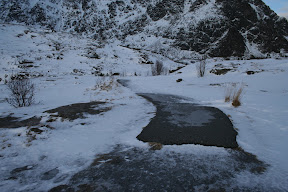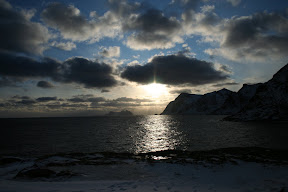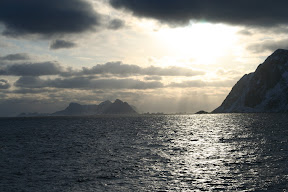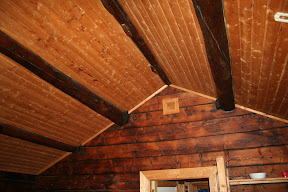Krino Island
Sunday, November 4, 2012
The next US president and the financial sector: just a coincidence?
US election time. Mainstream media are spending an huge amount of money to cover all sort of debates, pools, and talk, talk and still talk about useless things.
I think one of the most useful website to understand what is happening and which kind of policies will the future president promote, is Opensecrets.org.
It has an impressive amount of data: how much money is spent on this US presidential election, which sectors gives more money to which candidate, and so on.
I made a quick research and found some interesting stuffs. I found the total amount of money given by the sector defined as "Finance/Insurance/Real Estate" to the two main presidential candidates. And I present here the data for the three last US presidential elections (2012-2008-2004).
2004 elections:
The Finance sector gives 19 million more to Republicans than to Democrats.
Republican's George W. Bush wins.
2008 elections:
The Finance sector gives 11 million more to Democrats than to Republicans.
Democrat's Barack Obama wins.
2012 elections:
The Finance sector gives 34 million more (!) to Republicans than to Democrats.
..................
Now let's have a look at the "Top 5 contributors" to the two candidates:
Obama: University of Californa (1th), Microsoft, Google, US Government, Harvard.
Romney: Goldman Sachs (1th), Bank of America, Morgan Stanely, JPMorgan, Credit Suisse. I don't think I need to comment on it.
Conculsions? We cannot say that there is a causal relation, of course. And I cannot say that Mitt Romney will win the election because of this.
However, it is crystal clear that whoever will win, the financial sector will continue to play a fundamental role in the policy-making, as already does. Don't you believe it? It is plenty of evidence, for some more enterteining just have a look at the movie "Too big to fail".
On tuesday we will know if all this means something. Would it not be (at least) funny? Stay tuned!
Friday, July 16, 2010
Paid propaganda in the name of democracy
The premise is: Hugo Chavez's government in Venezuela, as many other democratically elected governments in Europe, USA and developed world, is far from perfect. But...my question is: do the Americans, the Europeans, and the Canadians know that their governments spend $40 million dollars to fund propagandistic projects in a foreign sovereign country, with the aim to provoke regime change? And, is this the international law?
I suggest you to read, and discuss, this article from Eva Gollinger on Znet, an independent non-corporated network of writers, journalists, and experts.
http://www.zcommunications.org/buying-the-press-by-eva-gollinger
Here some abstracts. I'd like to underline the fact that one ageny involved is "Freedom House", which is supposed to be independent (ah ah), and yearly gives a mark for the freedom of expression all over the world.....
US State Department documents declassified under the Freedom of Information Act (FOIA) evidence more than $4 million USD in funding to journalists and private media in Venezuela during the last three years. This funding is part of the more than $40 million USD international agencies are investing annually in anti-Chavez groups in Venezuela in an attempt to provoke regime change.
Today, corporate media outlets and their journalists use communications power to publicly promote the overthrow of the Venezuelan government. The owners and executives of these media corporations form part of the Venezuelan elite that, under the reigns of Washington, ran the country for forty years before Chavez won the presidency in 1998.
What these documents demonstrate is that Washington not only is funding Venezuelan media, in clear violation of laws that prohibit this type of “propaganda” and “foreign interference”, but also is influencing the way Venezuelan journalists perceive their profession and their political reality.
I'd like to ask to my American friends if this piece of news, which is quite serious politically, has been presented and discussed in any television news. About Italy, nothing has been said. They are so busy talking about Berlusconi (as always), hot weather, bikinis and beaches. In our case Freedom House is right: we are a partly free country.
Monday, June 28, 2010
Our trip over the norwegian polar artic circle, Lofoten islands - Last day!
The week off for the norwegians hits again. Our ferry which will bring us from Moskenes to Bodø, leaves at 7am in the morning. The bus should run at that time, but it's off for the skiing week. We leave at 5:30am to walk 5 kilometres with baggages, torches and reflecting stripes; well, to be honest these tools are useless because all the road is light up, but by wearing all these stuffs, we really look like professional trekkers.
Air is fresh and pleasant, and the early morning walk is very nice, in spite of the baggages we have to carry. The ferry is quiet, everyone is sleeping somewhere, and we try to rest too. During the trip, however, we have a quick excrusion on the outside, to leave or peace message to the world.
At 11 o'clock we arrive in Bodø, where the climate difference, compared to the Lofoten islands, is easily noticeable. Indeed, that day has been the coldest of all the year for the city, with -15.1 °C! It has been a proper goodbye to the Nordland region and the polar artic circle.
We make for the train station, but before we buy some food and drinks for the long journey. Yes, because we are going to go back by train! A little train, with only two wagons with a 19° century taste, but clean and comfortable. The diesel fueled motive will bring us through the immense snow-clad expanses toward south, Trondheim, the third biggest city in Norway.
The trip lasts 10 hours, from 12:15 to 22:10, but the time passes quite quickly. The landscape is unreal, and your thoughts almost stops while watching outisde the land covered by snow, with few vegetation, while in the south everything is covered by woods. We also catch a glimpse of elks, the national animal.
In Trondheim we just have the time to have a look around in the train station, buy something in the usual kiosk, and .... insert a coin in the wonderful train plastic model to let the train go. This, of course, attracts a lot of children. It's always nice to donate a smile to a children and an already-growth children! :)
The night train, from Trondheim to Oslo (from 23:05 to 6:43), is a very useful option to travel in Norway. It's cheap, comfortable with reclining seats and it gives you a not-to-be-missed souvenir from the norwegian rail company! A travel kit with a soft grey fleece, an inflating pillow and a pair of earplugs. When you'll see the grey fleece around the world, you'll know that the owner has been in this wonderful country.
After 18 hours of travelling, we arrive in Oslo. This time we have some hours to visit the city, which luckily it's small enough to walk around. If you are planning to stay in Oslo for one or more day, I really advice you to buy the Oslo Card, which will give you free public transports (which are very expensive, one-way ticket is around 30 nok) and free entrance to almost all the museums. If well planned, you'll save a lot of money and see a lot of sights.
Temperature is quite low, the sky is overcast, but we cannot miss the Vigelandsparken (about 3km from the train station), the famous park adorned by 212 bronze and rocky statues created by the norwegian artist Gustav Vigeland. The statues, which represent men, women and children, portray different moments of the life, and are really curious to see. I always found this park a place of reflection, and it's one of my favourite sight in Oslo.
Time, however, is passing fast, and we start to go back to the train station. One of the members of the Lofoten team will leave from Oslo Torp (and now you know where it is, see 1° day diary). To go there, you can choose between a comfortable train (224 nok adults, 168 nok students) or a direct bus (180nok).
Our trip finishes here. I hope that in the diary I succeded in finding a balance between details, practical tips and informations on local customs and traditions, without be boring. If you really dislike this, please comment and give me some advices on how to improve the next travel report. Ha det bra! Ciao!
To watch all the pictures in high quality (about 1000, taken with a Canon reflex EOS 350D 18-55mm, for the photograph enthusiastic) of our trip, click here.
Friday, April 30, 2010
Our trip over the norwegian polar artic circle, Lofoten islands - Day 5
On Monday, finally the bus schedule is richer than the weekend and we plan to visit two villages which, according to the guides, are worthy to see.
One of these is Reine, a good starting point for hikes, one of which sounds really interesting; unfortunately, it's not possible to do it because during the winter the trails is very difficult, and moreover, after two days of sun, clouds start to cover the islands and soon snow and wind will be with us!
The bus (39 nok) leaves us at the first destination, the farest from our basecamp in Sørvågen, which is Hamnøy: few houses on a small island at the end of the namesake fjord. On paper it should be a great viewpoint, but with bad weather it's not so interesting, and we just take a breath-taking look at the North sea from a sea cliff.
Hamnoy is connected with two nice bridges, which we across walking on the E10 towards South, to Sakrisøy, another small village on another small island. Here we leave the main road to take a wilder walk on the side, to have a better view on the fjord and the mountains. A small hill offers us the irresistible opportunity to roll along its side as a sack of potatoes....it's very funny, but the price to pay is to have snow everywhere on our clothes! Close to the hill we find a small pic-nic table which must be absolutely fantastic in the summer, with a great look on the fjord. Now it's winter, cloudy and windy, but we cannot resist to have a break and eat something.
After the break, we start again our walk on the E10 towards Reine; after some steps it starts to snow and the wind start to blow stronger. Luckily it's not so cold, because when it rains usually the temperature goes up, even if we need to walk completely covered, just with an opening for the eyes. Just after Sakrisøy we find a Coop supermarket which is perfect for a quick break! We also find that it has a lot of beautiful postcards and souvenirs, so it's a good occasion because tourist offices, in the winter season and in the weekend, are almost always closed. When we start again our walk, we are in the middle of the snowstorm, and when we finally reach Reine the weather starts to be good again. Reine is the last village, on the way to the South, where you can find some services as a ATM, where you can withdraw money with any credit/debit card. There is a nice kiosk too, with warm meals and souvernirs. Waiting for the bus, we take a walk to the cliff and the lighthouse, which is again made in iron, and colored in red and white. Maybe I've already talked about this, but these lighthouses, which stud the whole norwegian coastline from north to south, well they are particularly fascinating. They are there, alone against the wind and the waves, located in some amazing places like cliffs or small islands, and they make their job in an efficient way. We could say that they represent, in a way, the scandinavian efficiency which, despite the weather, is almost perfect.
On the cliff we find a big block of frozen ice, anchored to the ground....well, I know i'ts stupid, but we don't resist to try to detach it and make it roll in the sea. We succeed in the first task, but then we realize we're late for the bus...well, we weren't really late, because the bus was not running. Why? I ask to the lady in the Kiosk, who explains us that this week all the schools were closed, therefore the buses have a reduced timetable. But why? Well, the reason is that it's winter. Here the point; Norwegians can have an holiday just because it's winter, the weather is good, there is snow, and so....everybody is skiing! It's quite difficult to find a people more relaxed than this in Europe.
For us, stressed italian people, the only option now is to walk. It'sd 7 kilometres, and after a long day outside it's not a grea pleasure. Just after Reine there is also a short tunel, but the wise norwegians built an external path for pedestrians and cyclists. We try, in vain, to hitch-hike the few cars on our way unless, luckily, a car stops: it's the woman who were working in the kiosk.
In the evening we take bag and baggage for the last transfer to the other accomodation, because the ancient rorbu was already booked for another guest. The owner bring us to Å, the village that we visited the 4° day, in a spacious and modern rorbu. Our last dinner on the Lofoten island, worthy after the tirying day, was with three-coloured fusilli (red, green and white, the colours of the italian flag) with italian tomato sauce, "Taste of Sorrento", not before a tribute to the flag and national anthem.
Thursday, April 15, 2010
Our trip over the norwegian polar artic circle, Lofoten islands - Day 4
Forth day, and another wonderful sunny day which will follow us for an adventurous hike! The morning sunlight let us to enjoy Sørvågen, a traditional village, underestimated by the travel guide, located around an active harbour surrounded by superb mountains. It's a perfect base camp for hikes and in general to visit the nature of the southernmost island of the Lofoten archipelago, which is the most beautiful according to many travellers.
The owner of the accomodation recommends us to do an hike on the mountains around, so we start to walk in the direction of the mount which dominates the village, and surrounds on the right side a big frozen lake.
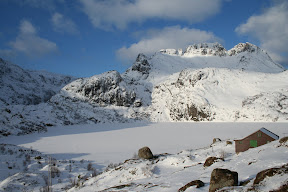
The climb is quite easy thanks to the soft snow which helps us not to become an human avalanche...and meter after meter the landscape becomes more and more breathtaking.

Finally on the peak we find a kind of plateau, at the slope of another mount which is too difficult to climb without any proper equipment and/or special skills, because of all the ice which covers its rocks. The view is amazing, and the light of the sun plays within the clouds giving an unreal effect.
On the plateau we find a long frozen sheet, like a perfect plate glass, and we cannot resist to the call of childhood, starting to slide on it in every possible way. After that, we take a break with hot tea (thanks to a very efficient thermos!) and crunchy norwegian chocolate. Then we start to descend to the frozen lake, and before placing our feet on it, we ask a man if it's safe. He reassures us: the ice is thick at least 50 centimetres!
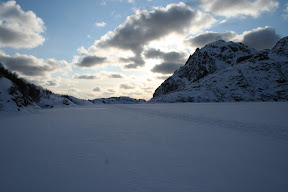
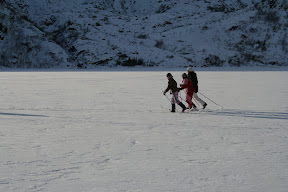
As you can see, norwegians really like the cross-country skiing during the winter. It's said that norwegians are born with ski on their feet, actually it's true! Even in Oslo, which is a modern city, you can often meet people getting on buses and trams wearing a ski suit and bringing ski or snowboards. At the side of the footpaths, where the snow cumulates, you can always find the track of the ski left by people who goes to school, work, or simly to enjoy the nature.
But let's go back to our hike. After a walk on the frozen lake we go downhill and take a small break at home, where we decide to go out again to watch the sunset from the very south point, at the end of the E10 road on the Lofoten. We start walking on the road, straight to the last village of the island, called Å (pronounced as a kind of closed O).
It's about 3 kilometres, and the sensation is really to be at the end of something. It's exciting to see the physical end of the road (picture below) and find the sea after some metres.
Over this coastline, flows of water combines in some spots called Maelstrom. In this area you can find the strongest maelmstrom in the world. Sunset is the perfect friend in these moment, and the clear sky let us to catch a glimpse of the last two small islands of the Lofoten, Vaerøya and Røst.
Now we can only go back home, very satisfied for this wonderful day. But the adventures are not finished yet: on the way back we meet the owners of the house where we are sleeping, a nice couple who owns over 17 houses in the villages of Å and Sørvågen, in addition to the stockfish museum and a youth hostel! The husband speaks an almost perfect italian, and invite us to spend the night in a really traditional Rorbu, which is also the oldest of the village. Built in 1985, it's practically untouched thanks to the ordinary care and some restorations. The athmosphere inside the cabin is warm, welcoming and cosy, the kitchen is folksy, the wood is everywhere. Here some pics, and see you next time!
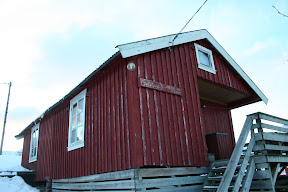
Sunday, March 28, 2010
Our trip over the norwegian polar artic circle, Lofoten islands - Day 3
DAY 3 (saturday 20 february 2010) - Svolvær - Henningsvær - Kabelvåg - Sørvågen
Our day starts early, and it has been carefully planned on the basis of the few buses travelling on saturday. The first one leaves slightly after the sunrise (which in february is about at 7am, while the sunset is at 17 pm), at 8:35am, when the fresh air combines with the wonderful colours of the sky behind the mountains. The trip takes just 30 minutes, but the ticket is very expensive, 57 nok, about 7 euro! Why? We ask to the conductor and find that the student discount (-50%) is applied only on the trip longer than 50km. Paradoxically, we pay more for a small displacement than a long one. However, the road network on the Lofoten is reduced to the essential, the roadway in many stretches is just sufficient for two cars, but everything is compensated by the sensation to drive in an unreal landscape. For some kilometres you may run on the slope of a mountain and you may believe to be on the Alps, then a wide valley opens up at your sight and after a while you find yourself on a winding road on the sea, few metres from the waves!
Our first destination is Henningsvær, called also the "Venice of the North". Well, for one who loves Venice like me, the paragon is very stretched. But while walking in the peaceful streets of the village, one can understand why someone thought about this similarity: canals, small houses on the water, and the whole village located in the middle of the sea, on a small island connected with the mainland just with a pair of bridges.
The limited size let you have an excellent view on the surroundings: at the sealine, on your back the mountains and a blue sky in place of the now gone sunset.
You can notice that Henningsvær is an important fishermen village by observing the wooden setting-up, typical on the Lofoten, used to dry the fish (on the left in the picture above). After a couple of hours the bus comes back and brings us to Kabelvåg, a bigger village and slightly more active, relatively to the Lofoten's standards. Here you can find a supermarket, a kiosk, and other useful services. After a break we head for the statue of King Øystein, who in 1120 ordered to build the first RORBU on the Lofoten. The rorobu is a small wooden house, built usually between the seaside and the land, similar to a pile-dwelling, born to give hospitality to the fishersmen during the fish season. On the Lofoten today the rorbuer (plural) are widespread as tourist accomodation during the summer. Many of them have all the comforts, losing a bit of the traditional fascination, but still being charming thanks to the wood and the unmistakable red color. The stone statue of the king enjoys a breathtaking view over Kabelvåg, with a 360 degree panorama view on sea, mountains and valleys.
We catch a glimpes of a cliff and a typical norwegian iron-lighthouse, painted in red and white. It's difficult to resist, and we go down the hill to reach it.
Before coming back to Svolvaer we cannot miss the Vågan kirke, the second largest wooden house in northern Norway, built in 1898.
In the evening it's planned a long displacement by bus which takes around 3 hours (117 nok), from the island of Austvågsøya, the northernmost of the Lofoten, to Moskenesøya, in the village of Sørvågen which will hold some nice surprises. The first is the accomodation, an amazing two-floor house all for us! Because of the low-season prices are really good, (we paid 150 nok per night per person + 80 nok to rent the linens) and there aren't a lot of tourists invading rorbuer, hotles and campings. This time we have a typical norwegian dinner, with boiled potatoes and a delicious tomato soup.
Friday, March 19, 2010
Our trip over the norwegian polar artic circle, Lofoten islands - Day 2
Day 2 (friday 19 february 2010) - Bodø - Svolvær
In Bodø the sun is shining and the sky is clear. We'll son get used to this climate which will stay with us all the days, except the last one. Perceived temperature is quite cold, some said that it's around -20 °C...however, it's ok and we walk to the tourist office in the city center. Opening hours during the winter, generally all around Norway, are very limited, so be sure to check before the departure. Unfortunately, this could not be enough...in fact, the tourist office is closed in spite of the written opening hours. Luckily, the nice and welcoming hall is opened, as the ferries' ticket-offices. We leave the baggages in the boxes, paying 50 nok for 24 hours. A kind old man approaches to us, asking if we need help. Ok, we have to debunk a myth before going on: norwegians, generally speaking, are not reserved or cold, but they are shy, which is different. Once you break the shyness, or in case of need, they are very kind and friendly! It's not unusual that if you are in the middle of a street trying to find your way with a map, some will voluntarily stop and ask if you need an help. Obviously, everyone here speaks english!
However, in the end the old man drive us on the top of an hill which dominate the city, a wonderful panoramic viewpoint you cannot miss to start the tour in the North! Up there, the North expresses itself through a cutting and cold wind....but the landscape and the sun let us to forget about the rest.
After exploring the surrounding, we start to go down following the road to the city center, where apparently there is nothing interesting to see, at least in the winter, so we have a look around in the shops. It has been a challenging decision, but in the end we decide to have lunch at Peppes Pizza, a norwegian chain which is everywhere in Norway: take some norwegians, put them making american-style pizza. The result, I'll be honest, is not so bad, but prices are high, as almost everything here.
After a quiet afternoon in Bodø, we take the ferry at 18:00 pm (162 nok, http://www.torghatten-nord.no/) to the Lofoten: it's comfortable, stable, and in time. We place our first foot on the Lofoten's ground at 21:35 in Svolvær. You can forget about big cities, crowded centers, traffic jam and cars. With less than 5000 people, Svolvær is one of the biggest city on the islands. And this says everything! City is desert, street lamps light the empty streets, the atmosphere is really enchanting.
The lights of a kiosk still opened contrast with the rest. We stop in the shop to ask how to reach our accomodation, which should be at walking distance from there. While we are walking we notice something in the sky, a kind of band, similar to a light cloud, almost invisible, blue colored. It's so weak that we have been in doubt for a long time, but in the end we realize that it was a northern light, even if almost invisible! Unfortunately it lasted for few minutes, and we didn't have the time to arrange everything and search for a good observation point to try to take some pictures. Well, it's not so bad, it's an invitation to come back in Norway in the future, hunting the northern lights!
Sjøhus camping is one of the cheapest accomodation in Svolvær, and it has a lot of wooden houses comfortable and suggestive, located on a sea canal. Moreover, almost all the cabins and houses of Lofoten are equipped with a kitchen, and this let us to prepare a good italian dinner, avoiding restaurants and sandwiches. Bon appetit!


